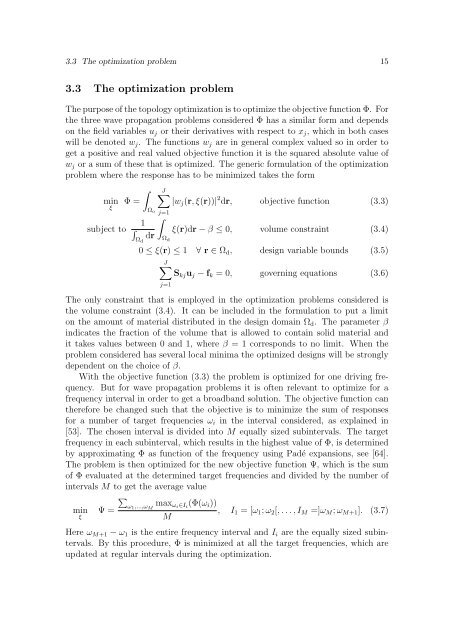Maria Bayard Dühring - Solid Mechanics
Maria Bayard Dühring - Solid Mechanics
Maria Bayard Dühring - Solid Mechanics
Create successful ePaper yourself
Turn your PDF publications into a flip-book with our unique Google optimized e-Paper software.
3.3 The optimization problem 15<br />
3.3 The optimization problem<br />
The purpose of the topology optimization is to optimize the objective function Φ. For<br />
the three wave propagation problems considered Φ has a similar form and depends<br />
on the field variables uj or their derivatives with respect to xj, which in both cases<br />
will be denoted wj. The functions wj are in general complex valued so in order to<br />
get a positive and real valued objective function it is the squared absolute value of<br />
wj or a sum of these that is optimized. The generic formulation of the optimization<br />
problem where the response has to be minimized takes the form<br />
min<br />
ξ<br />
subject to<br />
<br />
Φ =<br />
Ωo j=1<br />
J<br />
|wj(r, ξ(r))| 2 dr, objective function (3.3)<br />
1<br />
<br />
Ωd dr<br />
<br />
ξ(r)dr − β ≤ 0,<br />
Ωd<br />
volume constraint (3.4)<br />
0 ≤ ξ(r) ≤ 1 ∀ r ∈ Ωd, design variable bounds (3.5)<br />
J<br />
Skjuj − fk = 0, governing equations (3.6)<br />
j=1<br />
The only constraint that is employed in the optimization problems considered is<br />
the volume constraint (3.4). It can be included in the formulation to put a limit<br />
on the amount of material distributed in the design domain Ωd. The parameter β<br />
indicates the fraction of the volume that is allowed to contain solid material and<br />
it takes values between 0 and 1, where β = 1 corresponds to no limit. When the<br />
problem considered has several local minima the optimized designs will be strongly<br />
dependent on the choice of β.<br />
With the objective function (3.3) the problem is optimized for one driving frequency.<br />
But for wave propagation problems it is often relevant to optimize for a<br />
frequency interval in order to get a broadband solution. The objective function can<br />
therefore be changed such that the objective is to minimize the sum of responses<br />
for a number of target frequencies ωi in the interval considered, as explained in<br />
[53]. The chosen interval is divided into M equally sized subintervals. The target<br />
frequency in each subinterval, which results in the highest value of Φ, is determined<br />
by approximating Φ as function of the frequency using Padé expansions, see [64].<br />
The problem is then optimized for the new objective function Ψ, which is the sum<br />
of Φ evaluated at the determined target frequencies and divided by the number of<br />
intervals M to get the average value<br />
<br />
min<br />
ξ<br />
Ψ =<br />
ω1,...,ωM<br />
maxωi∈Ii (Φ(ωi))<br />
, I1 = [ω1; ω2[, . . . , IM =]ωM; ωM+1]. (3.7)<br />
M<br />
Here ωM+1 − ω1 is the entire frequency interval and Ii are the equally sized subintervals.<br />
By this procedure, Φ is minimized at all the target frequencies, which are<br />
updated at regular intervals during the optimization.
















